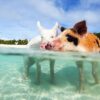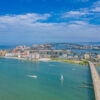Swimming Pigs of Abaco

The image most of us conjure up when we hear the word “pig” usually
involves a swine wallowing in gallons of mud. However, in the tropical
paradise of The Bahamas, pigs have a different approach to life.
Here,
feral pigs roam free on some of our sugar-sand beaches with their
sparkling waters, and enjoy an endless stream of fans coming to visit.
They’re far from snobbish, though: These pigs are friendly, extroverted
creatures who happily swim and pose for photos with their human
admirers.
Where to find them
Located
almost directly to the north of Nassau are the Abaco Islands. Our
Abacos, are blessed with plentiful brilliant turquoise bays and some of
the Caribbean’s most stunning beaches. And we have swimming pigs! They
live just across the bay from Bahama Beach Club on No Name Cay,
endearingly nicknamed “Piggyville” by local residents.
Why visit the pigs?
How
often do you see an irresistibly cute pig, seeming to smile, paddling
through the ocean towards you? Being able to get up close and personal
with the not-so-wildlife is one of our islands’ most beloved oddities.
Even
for tourists who aren’t animal mad, visiting the swimming pigs is a
special experience. You can see and feed the adorable and friendly
Pigville swimming pigs on a 2.5-hour excursion, or enjoy it as part of
our Island-Hopping Sunday Day Tour.
These unique animals make for a fantastic photo opportunity! Though the pigs are stars on Instagram (see them here) and Facebook (see them here), nothing beats the opportunity to snap some shots in person, and a fun and unusual thing to take home to show the family.
The
pig populations are supplied with fresh water, fruits and vegetables by
the local guides who visit, and visitors are often given the
opportunity to feed them as well. After all, the cute pigs have become a
vital tourist attraction, and maintaining their health benefits both
the pigs and the people who visit them. Regardless of the food supply,
pigs are pigs and will delightedly accept any offerings of food. Many
tourists find it to be an exciting experience, and it can be very
rewarding when the pigs show affection in return. Just keep your hands a
safe distance away from eager piggy mouths.
How did the pigs get there?
The
humble pig is not native to the Caribbean, let alone any tropical
climates. The modern-day domestic pig is thought to have descended from
various species of wild boars, which originated in Europe and Asia. Pigs
naturally live worlds away from the Caribbean, yet they still managed
to establish small but successful populations in The Bahamas.
As
with most misplaced species, the pigs were introduced to The Bahamas by
migrating humans. Pork is a much-loved staple of a classic European
diet, so where the English went, the pigs went with them. However, the
exact way the pigs reached No Name Cay is unknown.
One of the
theories is that a group of sailors placed them here to provide a food
source later, but never returned. Similar theories replace the sailors
with concerned residents of the nearby Staniel Cay, planning a livestock
farm in case of a lack of food supplies hit The Bahamas. The most
exciting theory is that the original pigs were survivors of a shipwreck
and managed to swim to the shore and continue their lives on the island.
No
matter where they came from, the pigs have shown great resilience and
adaptability. The pigs have populated this small island for generations
now, surviving from the nutrition the land provides and the generosity
of locals and the tourists who visit them. It’s an impressive effort
that emphasizes the pigs’ determination and will to survive.
Want to get your own adorable dose of swimming pigs? Bahama Beach Club’s activities partner Brendal’s Dive Center can introduce you.



